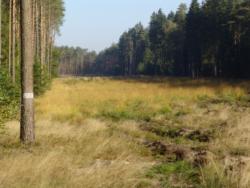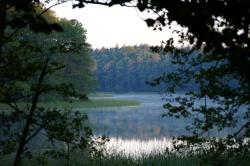 Asset Publisher
Asset Publisher
Polish forests
Poland is in the European lead, while concerning the area of all forests. They cover about 29,2 % of the country territory, and grow within the area of 9,1 million hectares. The overwhelming majority of the forests is state owned, of which almost 7,6 million hectares are managed by the State Forests National Forest Holding..
The number of Polish forest is still growing. The forestation rate of the country has increased from 21 % in 1945 to 29,2 % at the moment. Between 1995 and 2008, the forest area increased by 310 thousand ha. The basis for afforestation works is the "National Programme for Increasing the Forest Cover" (KPZL), assuming an increase of the forestation rate up to 30 % by 2020 and up to 33 % by 2050. Polish forests abound in flora, fauna and fungi. 65 % of the total number of animal species live there.
The forests grow in our country on poor soils, mainly because of the development of the agriculture in previous years. It influences the distribution of the types of the forest sites in Poland. Over 55 % of the forest areas is covered with coniferous forests. In other areas, there are forest sites, mainly the mixed ones. Their small part constitute alder and riparian forests – not more than 3 %.
In the years 1945 – 2011 the area of natural deciduous tree stands within the area of the State Forests National Forest Holding increased from 13 to 28,2 %.
Within the lowlands and uplands the most often occurring tee species is pine. It covers 64,3 % of the forest area of the State Forests National Forest Holding and 57,7 % of private and commune forests. In the mountains the predominant species is European spruce ( in the west) and European spruce with beech (in the east). Domination of pine is the result of carrying on sustainable forest management in the past. Once, the monocultures (crops or cultivations of one species) were the answer to the great demand of industry for wood. Such forests appeared to be quite fragile to climatic factors. They also were often the prey of pests' expansion.
In Polish forests, the share of other tree species, especially deciduous trees have been systematically increasing. The foresters have stepped aside from monocultures – that is why, they try to fit specific species of the forest stand to the natural stand, that would be proper for the given area. Thanks to that, in the years 1945 – 2011, the area of the deciduous tree stands within the lands of the State Forests National Forest Holding increased from 13 to 28,2 %. There occur more and more frequently the following tree species: oaks, ashes, maples, sycamore maples, elms, but also birches, beeches, alders, poplars, hornbeams, aspens, tilias and willows.
Our forests are the most often represented by the forest stands aged 40 to 80 years. The average age of the forest equals 60 years. More and more trees are of big size at the age over 80 years. Since the end of the Second World War, the forests' area has increased up to almost 1,85 million hectares.
Raport o stanie lasów w Polsce 2012
 Asset Publisher
Asset Publisher
 Asset Publisher
Asset Publisher
Nasze lasy
Nasze lasy
Nadleśnictwo Wałcz leży na terenie gmin: Wałcz, Jastrowie, Mirosławiec, Miasto Wałcz; Krainie Wielkopolsko – Pomorskiej ( III); Mezoregionach: Pojezierza Wałeckiego (III-6) i Równiny Wałeckiej (III-7)
Nadleśnictwo Wałcz położone jest w południowo-wschodniej części województwa zachodniopomorskiego oraz w północno-zachodniej części województwa wielkopolskiego.
Pod względem podziału administracyjnego stworzonego w Lasach Państwowych Nadleśnictwo Wałcz jest jednym z 20 Nadleśnictw wchodzących w skład Regionalnej Dyrekcji Lasów Państwowych w Pile.
Zgodnie z Zarządzeniami Nadleśniczego NR 58/2013 z dnia 30.12.2013 roku i NR 57/2014 z dnia 30.12.2014 roku Nadleśnictwo Wałcz od dnia 01.01.2015r. roku składa się z 11 leśnictw (taka sama ilość jak w poprzednim 10-leciu) położonych w jednym obrębie leśnym Wałcz.
Budowa geologiczna gleby: Na terenie Nadleśnictwa Wałcz dominują gleby rdzawe zajmujące około 83% powierzchni. Pozostałą część zajmują odpowiednio gleby: bielicowe, murszowe, torfowe, murszowate, płowe i gruntowoglejowe.
Przeciętna wysokość: 110-160 m. n.p.m.
Klimat: Klimat obszaru Nadleśnictwa Wałcz został zakwalifikowany (wg Gumińskiego) do pomorskiej dzielnicy rolniczo-klimatycznej. Na terenie tym ścierają się wpływy klimatu morskiego i kontynentalnego, przy czym większy udział przejawiają cechy pierwszego z wymienionych.
Opady atmosferyczne wynoszą ok. 600 mm rocznie. Średnia temperatura roczna wynosi ok. 7,5oC; średnia temp. stycznia od –2,0oC do –2,5oC; średnia temp. lipca od 17,0oC do 17,5oC.
Długość okresu wegetacyjnego wynosi ok. 200 dni. Przymrozki wiosenne występują do 30 kwietnia w skrajnych przypadkach do 30 maja. Czas trwania zimy wynosi przeciętnie 80-90 dni, a czas zalegania pokrywy śnieżnej wynosi ok. 50-60 dni.
Powierzchnia ogólna: 17150,79 ha , w tym leśna 15934,78 ha.
Przeciętna zasobność drzewostanów: 262 m3/ha
Przeciętny wiek drzewostanów: 58 lat
Struktura wiekowa drzewostanów wg powierzchni przedstawia się następująco:
|
Klasy i podklasy wieku |
stan na 01.01.2015r. |
|
|---|---|---|
|
ha / m3 |
% |
|
|
|
|
|
|
Przestoje |
46947 |
1,13 |
|
Ia |
989,14 |
6,36 |
|
90 |
0,00 |
|
|
Ib |
1393,41 |
8,96 |
|
37705 |
0,91 |
|
|
IIa |
1275,36 |
8,20 |
|
124125 |
2,98 |
|
|
IIb |
1080,06 |
6,94 |
|
200405 |
4,82 |
|
|
IIIa |
1733,27 |
11,14 |
|
507905 |
12,21 |
|
|
IIIb |
3011,11 |
19,36 |
|
977980 |
23,51 |
|
|
IVa |
1602,91 |
10,30 |
|
549225 |
13,20 |
|
|
IVb |
869,79 |
5,59 |
|
310715 |
7,47 |
|
|
Va |
1209,28 |
7,77 |
|
471630 |
11,34 |
|
|
Vb |
685,41 |
4,41 |
|
251820 |
6,05 |
|
|
VI |
874,19 |
5,62 |
|
378325 |
9,09 |
|
|
VII |
203,66 |
1,31 |
|
87420 |
2,10 |
|
|
VIII i wyższe |
114,99 |
0,74 |
|
55105 |
1,32 |
|
|
KO |
496,59 |
3,19 |
|
153780 |
3,70 |
|
|
KDO
|
15,54 |
0,10 |
|
6875 |
0,17 |
|
|
Ogółem |
15554,71 |
100 |
|
4160052 |
100 |
|
Udział typów siedliskowych lasu (typów żyzności gleby ) :
|
Typ siedliskowy |
pow. ha |
% |
|
1 |
4 |
5 |
|
Bśw |
6430,17 |
40,35 |
|
Bw |
0,48 |
0,00 |
|
BMśw |
5119,68 |
32,13 |
|
BMw |
285,99 |
1,79 |
|
BMb |
82,14 |
0,52 |
|
LMśw |
2513,84 |
15,78 |
|
LMw |
158,94 |
1,00 |
|
LMb |
62,03 |
0,39 |
|
Lśw |
472,70 |
2,97 |
|
Lw |
53,37 |
0,33 |
|
Ol |
556,20 |
3,49 |
|
OlJ |
144,94 |
0,91 |
|
Lł |
54,30 |
0,34 |
|
Ogółem |
15934,78 |
100 |
Przyjęte wieki rębności
Db, Js – 140 lat
So, Md, Bk – 100 lat
Św, Brz, Ol, Gb, Kl – 80 lat
Os, Olsz – 60 lat
Tp – 40 lat
W Nadleśnictwie Wałcz rocznie wysadza się w ramach zalesień gruntów porolnych i odnowień na powierzchniach otwartych ok. 177 hektarów, a średnia ilość pozyskiwanego drewna to 90887 m3 rocznie.


 fot. Paweł Fabijański
fot. Paweł Fabijański
 fot. Paweł Fabijański
fot. Paweł Fabijański
 fot. Paweł Fabijański
fot. Paweł Fabijański










